What's inside
What's inside
 Key Ingredients
Key Ingredients

 Benefits
Benefits

 Concerns
Concerns

 Ingredients Side-by-side
Ingredients Side-by-side

Water
Skin ConditioningCetearyl Alcohol
EmollientBehentrimonium Chloride
PreservativeCetyl Esters
EmollientLactic Acid
BufferingPhenoxyethanol
PreservativeArginine
MaskingTrideceth-6
EmulsifyingChlorhexidine Digluconate
AntimicrobialLimonene
PerfumingPanthenol
Skin ConditioningAmodimethicone
Isopropyl Alcohol
Solvent2-Oleamido-1,3-Octadecanediol
Skin ConditioningBiotin
AntiseborrhoeicPotassium Hydroxide
BufferingCetrimonium Chloride
AntimicrobialParfum
MaskingWater
Skin ConditioningSodium Laureth Sulfate
CleansingCocamidopropyl Betaine
CleansingDimethiconol
EmollientTea-Dodecylbenzenesulfonate
CleansingTrideceth-10
CleansingPropylene Glycol
HumectantMilk Extract
Skin ConditioningGlycerin
HumectantXanthan Gum
EmulsifyingPisum Sativum Extract
Skin ConditioningPhenoxyethanol
PreservativeSodium Benzoate
MaskingSodium Chloride
MaskingCarbomer
Emulsion StabilisingGuar Hydroxypropyltrimonium Chloride
Skin ConditioningSodium Hydroxide
BufferingSalicylic Acid
MaskingDisodium EDTA
Parfum
MaskingMica
Cosmetic ColorantTitanium Dioxide
Cosmetic ColorantCitric Acid
BufferingWater, Sodium Laureth Sulfate, Cocamidopropyl Betaine, Dimethiconol, Tea-Dodecylbenzenesulfonate, Trideceth-10, Propylene Glycol, Milk Extract, Glycerin, Xanthan Gum, Pisum Sativum Extract, Phenoxyethanol, Sodium Benzoate, Sodium Chloride, Carbomer, Guar Hydroxypropyltrimonium Chloride, Sodium Hydroxide, Salicylic Acid, Disodium EDTA, Parfum, Mica, Titanium Dioxide, Citric Acid
Ingredients Explained
These ingredients are found in both products.
Ingredients higher up in an ingredient list are typically present in a larger amount.
Parfum is a catch-all term for an ingredient or more that is used to give a scent to products.
Also called "fragrance", this ingredient can be a blend of hundreds of chemicals or plant oils. This means every product with "fragrance" or "parfum" in the ingredients list is a different mixture.
For instance, Habanolide is a proprietary trade name for a specific aroma chemical. When used as a fragrance ingredient in cosmetics, most aroma chemicals fall under the broad labeling category of “FRAGRANCE” or “PARFUM” according to EU and US regulations.
The term 'parfum' or 'fragrance' is not regulated in many countries. In many cases, it is up to the brand to define this term.
For instance, many brands choose to label themselves as "fragrance-free" because they are not using synthetic fragrances. However, their products may still contain ingredients such as essential oils that are considered a fragrance by INCI standards.
One example is Calendula flower extract. Calendula is an essential oil that still imparts a scent or 'fragrance'.
Depending on the blend, the ingredients in the mixture can cause allergies and sensitivities on the skin. Some ingredients that are known EU allergens include linalool and citronellol.
Parfum can also be used to mask or cover an unpleasant scent.
The bottom line is: not all fragrances/parfum/ingredients are created equally. If you are worried about fragrances, we recommend taking a closer look at an ingredient. And of course, we always recommend speaking with a professional.
Learn more about ParfumPhenoxyethanol is a preservative that has germicide, antimicrobial, and aromatic properties. Studies show that phenoxyethanol can prevent microbial growth. By itself, it has a scent that is similar to that of a rose.
It's often used in formulations along with Caprylyl Glycol to preserve the shelf life of products.
Water. It's the most common cosmetic ingredient of all. You'll usually see it at the top of ingredient lists, meaning that it makes up the largest part of the product.
So why is it so popular? Water most often acts as a solvent - this means that it helps dissolve other ingredients into the formulation.
You'll also recognize water as that liquid we all need to stay alive. If you see this, drink a glass of water. Stay hydrated!
Learn more about Water